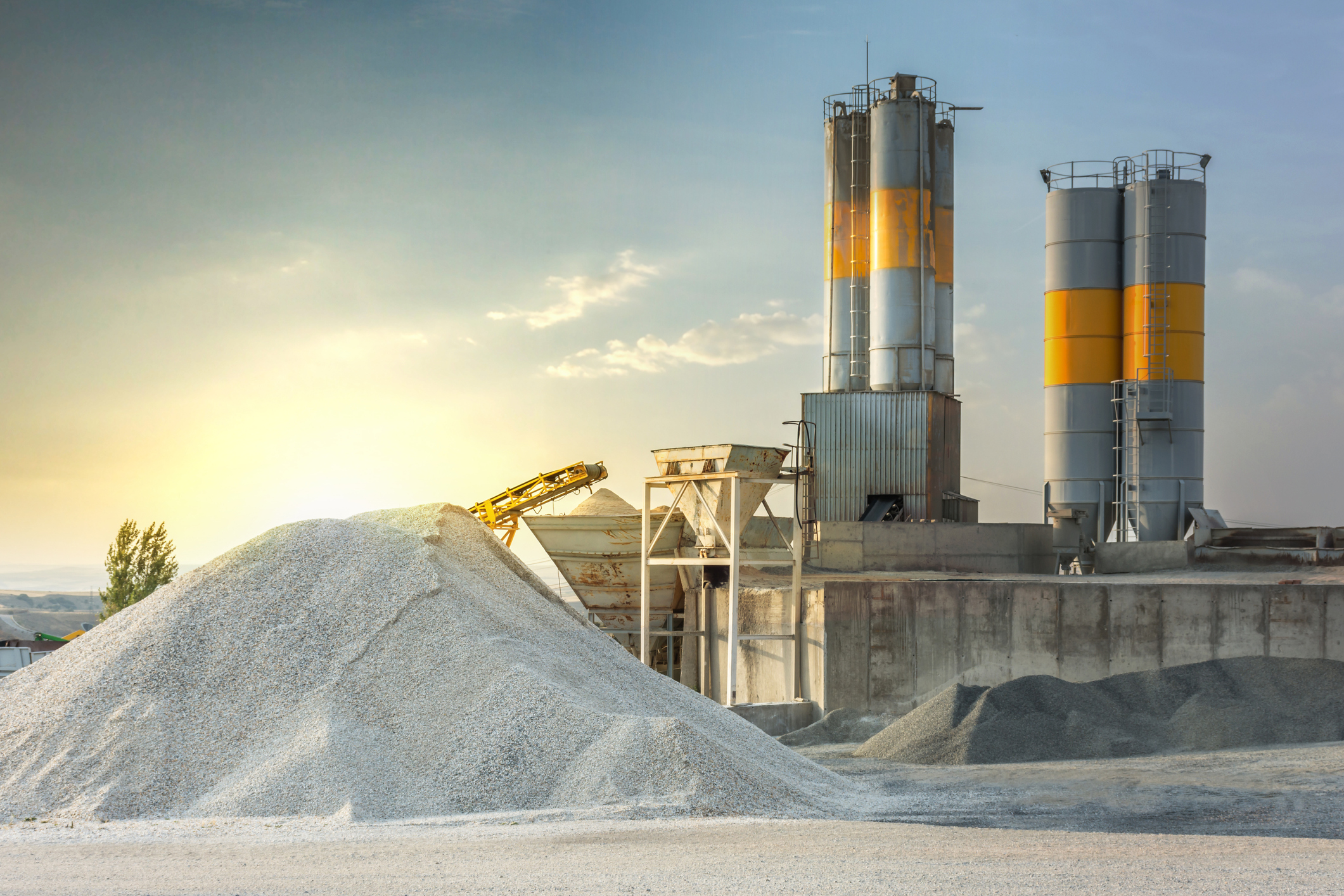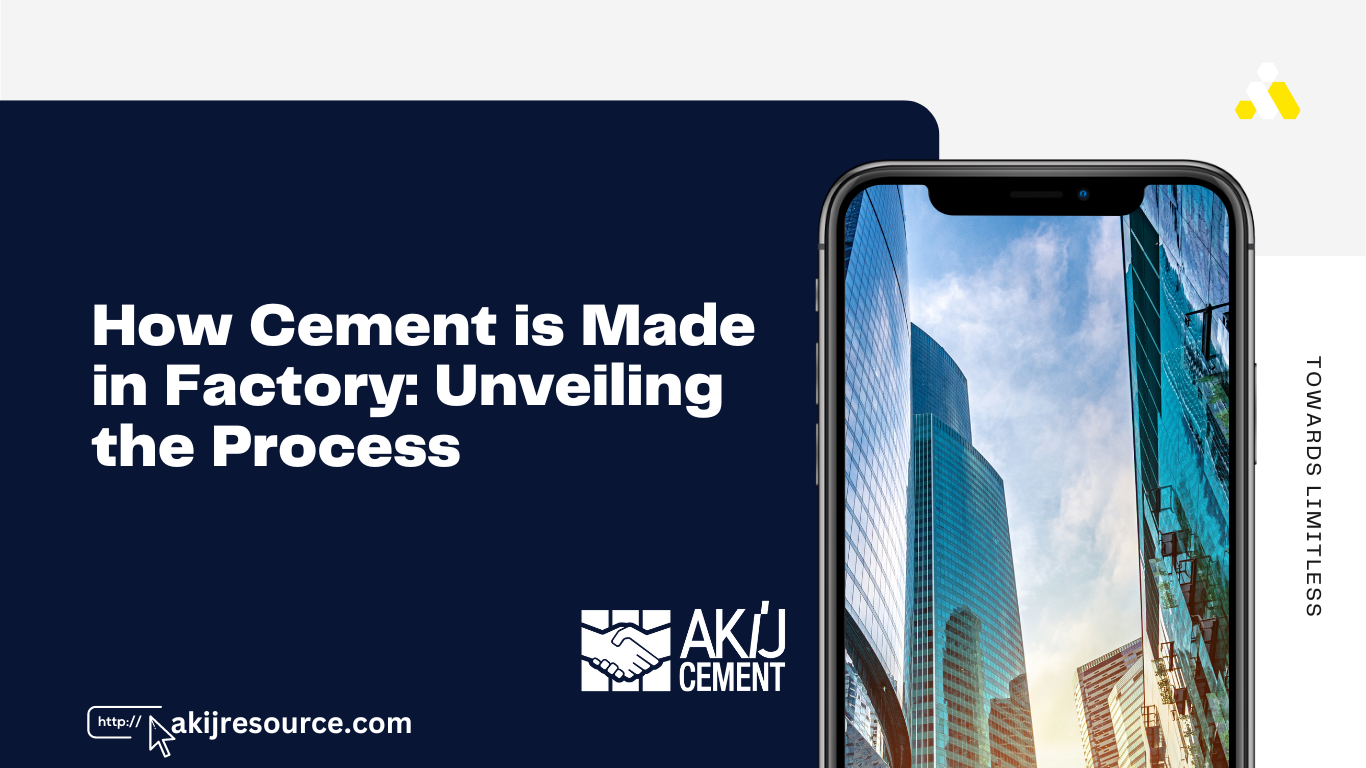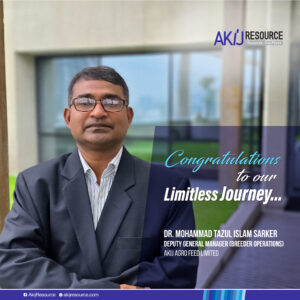Cement is made in factories by heating limestone and clay in a kiln to form clinker, which is then ground into powder. This process involves multiple stages including raw material extraction, grinding, and heating.
Cement production starts with the extraction of raw materials like limestone, clay, and sand. These materials are crushed and blended to create a uniform mixture. The mixture is then heated in a kiln at high temperatures, forming clinker. Clinker, small nodules of mixed materials, is cooled and ground to a fine powder.
Gypsum is added to regulate the setting time of the cement. The final product is then packaged and distributed for various construction applications. This intricate process ensures the production of high-quality cement, essential for modern infrastructure.

Credit: www.thermofisher.com
Introduction To Cement Production
Cement is a key ingredient in modern construction. It binds other materials together. Understanding how cement is made helps us appreciate its role in building.
The process of making cement in a factory is complex. It involves several stages, each critical to producing quality cement. Let’s explore how cement production starts and its significance.
The Importance Of Cement
Cement is essential for construction. It forms the backbone of our infrastructure. From bridges to buildings, cement holds everything together. Without it, structures would not be as strong or durable.
Cement is versatile. It can be used in various construction types. It is suitable for homes, roads, and even skyscrapers. This versatility makes it invaluable in the construction industry.
Cement is cost-effective. It offers a great balance between cost and strength. This makes it an ideal choice for many projects. Builders prefer it for its reliability and affordability.
A Brief History
The history of cement dates back to ancient times. The Romans used a form of cement in their buildings. They mixed volcanic ash with lime to create a strong material.
Modern cement production began in the 19th century. Joseph Aspdin, an English mason, patented Portland cement in 1824. This type of cement is still used today. It is named after the Isle of Portland because of its similarity to the stone found there.
The cement industry has evolved. Advances in technology have improved production methods. Factories now produce cement more efficiently and sustainably. This progress has made cement more accessible and affordable worldwide.
Raw Material Extraction
Understanding how cement is made starts with the raw material extraction process. This step is crucial as it provides the necessary ingredients for cement production. The quality and type of raw materials significantly impact the final product.
Types Of Raw Materials
Cement production requires specific raw materials. The key ingredients include limestone, clay, and sand. Each material plays a unique role in cement’s composition:
- Limestone: Primary source of calcium.
- Clay: Provides silica, alumina, and iron.
- Sand: Supplies additional silica.
These raw materials must be carefully selected and mixed to ensure a high-quality cement product.
Methods Of Quarrying
The extraction of raw materials involves various quarrying methods. Here are the most common techniques:
- Open-pit mining: Suitable for extracting large quantities of limestone.
- Drilling and blasting: Used to break up hard rock layers.
- Excavation: Involves removing loose materials and transporting them to the factory.
Each method has its own advantages and is chosen based on the location and type of material.
Quarrying is an essential process in cement production. Ensuring efficient and environmentally-friendly methods is crucial for sustainability.
Material Preparation
Material preparation is a critical stage in the cement manufacturing process. This stage ensures that the raw materials are ready for the subsequent steps, such as heating and mixing. Proper preparation enhances the quality and efficiency of the final product. Below, we explore two key components of material preparation: crushing and grinding, and proportioning of ingredients.
Crushing And Grinding
The first step in material preparation is crushing and grinding. Raw materials like limestone and clay are extracted from quarries. These materials are then transported to the factory.
Once at the factory, the raw materials are crushed into smaller pieces. This makes them easier to handle. The crushed materials are then ground into a fine powder. This powder is called raw meal.
The grinding process can be done in two ways:
- Ball mills: These are large rotating cylinders filled with steel balls. As the cylinder rotates, the balls crush the raw materials into a fine powder.
- Vertical roller mills: These use rollers that crush the materials against a rotating table.
Both methods achieve the same goal: creating a fine, uniform powder that can be easily mixed with other ingredients.
Proportioning Of Ingredients
Once the raw materials are crushed and ground, the next step is proportioning the ingredients. This ensures that the final cement product has the right chemical composition.
Various raw materials need to be blended in specific ratios:
| Ingredient | Percentage |
|---|---|
| Limestone | 60-65% |
| Clay | 20-25% |
| Iron ore | 2-4% |
| Sand | 5-10% |
A computer-controlled system often handles the proportioning. This ensures accuracy and consistency in the mixture. The ingredients are then mixed together to form a homogeneous blend.
This blend is crucial for the next stage of the process, where the materials are heated in a kiln.
Blending And Homogenization
Blending and homogenization are critical steps in cement production. This process ensures the final product has consistent quality. By blending raw materials, the cement factory can achieve uniform chemical composition. This guarantees the cement’s strength and durability.
Blending Techniques
Factories use various blending techniques to mix raw materials. The two main techniques are dry blending and wet blending. In dry blending, materials are mixed without water. This technique is efficient and cost-effective. Wet blending involves adding water to the raw materials. This method helps achieve a more uniform mixture. Both techniques have their own advantages.
- Dry Blending: Efficient and cost-effective.
- Wet Blending: Ensures a uniform mixture.
Ensuring Consistency
Ensuring consistency in cement production is vital. Factories use automated systems to monitor the blending process. These systems adjust the proportions of raw materials. This guarantees a consistent chemical composition. Consistency is key to producing high-quality cement.
Several factors influence consistency:
- Raw Material Quality: High-quality raw materials lead to better cement.
- Blending Equipment: Advanced equipment ensures precise mixing.
- Automated Systems: These systems monitor and adjust the blending process.
By focusing on these factors, factories produce reliable and durable cement. Consistency in blending and homogenization is essential for the construction industry.
Preheating And Calcining
Preheating and calcining are crucial steps in cement production. These processes prepare raw materials for clinker formation. This preparation ensures high-quality cement. Let’s explore these stages in detail.
The Role Of Preheaters
Preheaters are tall structures used to heat raw materials. They use hot gases from the kiln. This preheating reduces energy consumption. It makes the process more efficient.
Preheaters consist of several cyclones. Each cyclone heats the material further. The raw materials enter at the top. They pass through each cyclone, getting hotter. By the time they reach the bottom, they are ready for calcination.
Calcination Explained
Calcination is a key chemical process. It occurs in the kiln. Here, limestone decomposes into lime and carbon dioxide. This reaction happens at high temperatures, around 900°C.
Calcination transforms raw materials into clinker. Clinker is then ground to make cement. The process also releases CO2, a greenhouse gas. Modern plants use technologies to reduce emissions.
Key points of calcination:
- Occurs at 900°C or higher.
- Decomposes limestone into lime and CO2.
- Transforms raw mix into clinker.
- Essential for cement quality.

Credit: www.thermofisher.com
Clinker Production In The Kiln
Clinker production is a crucial step in the cement manufacturing process. The kiln is where raw materials are transformed into clinker. This transformation occurs through high-temperature chemical reactions. Understanding this process is key to grasping how cement is made.
The Kiln: Heart Of The Process
The kiln is the heart of the clinker production process. This massive cylindrical structure rotates slowly. Inside, temperatures soar to 1450 degrees Celsius.
The kiln consists of three zones: the drying zone, the calcining zone, and the sintering zone.
| Zone | Temperature (Celsius) | Function |
|---|---|---|
| Drying Zone | Up to 200 | Removes moisture from raw materials |
| Calcining Zone | 800-1000 | Initiates chemical reactions |
| Sintering Zone | 1450 | Forms clinker |
In the drying zone, raw materials lose moisture. In the calcining zone, they undergo chemical changes. Finally, in the sintering zone, clinker forms.
Chemical Reactions At Play
In the kiln, several key chemical reactions occur. These reactions transform raw materials into clinker.
- Decomposition of calcium carbonate (CaCO3): This reaction produces calcium oxide (CaO) and carbon dioxide (CO2).
- Formation of dicalcium silicate (C2S): This reaction occurs between CaO and silicon dioxide (SiO2).
- Formation of tricalcium silicate (C3S): This reaction occurs at the highest temperatures in the kiln.
The chemical reactions are vital. They ensure the formation of high-quality clinker. The quality of clinker directly impacts the quality of cement.
Cement Grinding And Distribution
The final stage in cement production is cement grinding and distribution. This step is crucial. It ensures that the cement meets the required quality and performance standards. The process involves grinding the clinker and mixing it with additives. The resulting powder is then stored and packaged for distribution.
Grinding Mills And Technology
Grinding mills are essential in the cement grinding process. These mills grind the clinker into fine powder. There are different types of mills used:
- Ball mills: These are cylindrical devices filled with grinding media. They rotate to grind the clinker.
- Vertical roller mills: These use large rollers to grind the clinker. They are more efficient than ball mills.
- Roller presses: These use high pressure to grind the clinker. They are often used with ball mills for better efficiency.
Modern technology has improved the efficiency of grinding mills. Advanced control systems monitor the grinding process. They ensure the final product meets quality standards.
Storage And Packaging
After grinding, the cement is stored in silos. These silos protect the cement from moisture and contamination. The cement is then ready for packaging.
Packaging is an important step in cement distribution. The cement is packed in bags or bulk containers. The bags come in different sizes, usually 50 kg each. Bulk containers are used for large-scale projects.
| Packaging Type | Usage |
|---|---|
| Bags | Commonly used for retail and small projects. |
| Bulk Containers | Used for large construction projects. |
Proper storage and packaging ensure the cement retains its quality. It also makes transportation easier and safer.

Credit: www.britannica.com
Quality Control Measures
Ensuring the quality of cement is crucial in manufacturing. Factories use strict quality control measures to produce high-quality cement. These measures ensure the cement meets the required standards and specifications.
Laboratory Testing
Laboratory testing is a key step in the quality control process. It involves analyzing raw materials and finished products. Technicians collect samples at various production stages. They test these samples for chemical composition and physical properties.
Some common tests include:
- Chemical analysis: Determines the chemical makeup of the raw materials and cement.
- Physical tests: Measures properties like fineness, compressive strength, and setting time.
- X-ray fluorescence (XRF): Identifies and quantifies elements in the samples.
The results of these tests help adjust the production process. This ensures the final product meets quality standards.
Automation In Quality Assurance
Automation plays a significant role in quality assurance. Automated systems monitor and control the production process. They help maintain consistent quality by reducing human errors.
Key benefits of automation include:
- Continuous monitoring: Automated systems provide real-time data on production parameters.
- Improved accuracy: Machines perform precise measurements and adjustments.
- Efficiency: Automation speeds up the production process and reduces downtime.
Factories use various automated tools and technologies. These include sensors, control systems, and software applications. They ensure every batch of cement meets the required quality standards.
In summary, quality control measures in cement factories are essential. Laboratory testing and automation ensure consistent and high-quality cement production.
Environmental Impact And Sustainability
Cement production has a significant environmental impact. Factories release greenhouse gases and consume natural resources. To address this, the industry is adopting sustainable practices.
Emission Controls
Factories are implementing emission control technologies to reduce pollution. These technologies capture harmful gases before they reach the atmosphere. Below are some common methods:
- Electrostatic Precipitators: Capture dust particles using electrical charges.
- Bag Filters: Trap fine particles using fabric filters.
- Scrubbers: Use liquid to wash out pollutants from exhaust gases.
Alternative Fuels And Raw Materials
Using alternative fuels and raw materials helps reduce the environmental impact. Factories are exploring various options to replace traditional fuels and raw materials.
| Alternative Fuels | Alternative Raw Materials |
|---|---|
| Biomass | Fly Ash |
| Waste Oils | Slag |
| Tires | Silica Fume |
Biomass and waste oils are renewable and reduce carbon emissions. Fly ash, slag, and silica fume are industrial byproducts that can replace some raw materials in cement.
Implementing these sustainable practices helps the cement industry reduce its environmental footprint. It also conserves natural resources for future generations.
The Future Of Cement Manufacturing
The cement industry is evolving rapidly. New technologies promise to make production more efficient and eco-friendly. This section explores the future of cement manufacturing.
Innovations In Production
Modern cement factories use cutting-edge technologies. These innovations help reduce energy consumption and emissions. Some key advancements include:
- Alternative Fuels: Factories now use waste materials as fuel, reducing reliance on fossil fuels.
- Carbon Capture: New systems capture and store CO2 emissions, making the process greener.
- Smart Sensors: Advanced sensors monitor and optimize production in real-time.
Challenges And Opportunities
The industry faces several challenges but also has many opportunities. One major challenge is the high energy consumption in cement production. Factories need to find ways to use energy more efficiently. Another challenge is environmental impact. Cement production releases a lot of CO2. Factories are working on methods to reduce these emissions.
Despite these challenges, there are many opportunities. Sustainable practices can lead to cost savings and a better public image. Innovative materials and techniques can improve the quality of cement. Factories that adopt these changes will be leaders in the industry.
Is the Process of Making Cement in a Factory Similar to Making a Cement Fountain?
The process of making cement in a factory is not similar to making a cement fountain. While the production of cement involves large-scale mixing and heating of raw materials, a cement fountain is typically made using a stepbystep cement fountain tutorial that focuses on molding and shaping the cement for decorative purposes.
Frequently Asked Questions
How Is Cement Manufactured Step By Step?
Cement manufacturing involves quarrying limestone and clay, crushing them, mixing, heating in a kiln, and grinding into fine powder.
What Are The Raw Materials For Cement?
The raw materials for cement include limestone, clay, shale, and gypsum. These materials are mixed, heated, and ground.
How Is Concrete Made In A Factory?
Concrete is made by mixing cement, water, sand, and aggregates in precise proportions. The mixture is then poured into molds and cured.
How To Make Cement Step By Step?
Mix limestone and clay, then heat the mixture in a kiln to form clinker. Grind the clinker with gypsum.
Conclusion
Understanding how cement is made in a factory highlights its importance in construction. The process involves raw material extraction, grinding, heating, and cooling. Each step ensures quality and strength. By knowing this, we appreciate the innovation and effort behind every cement product.
Cement production is crucial for building durable structures.






















